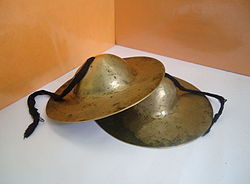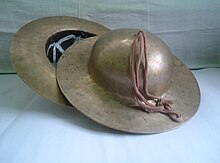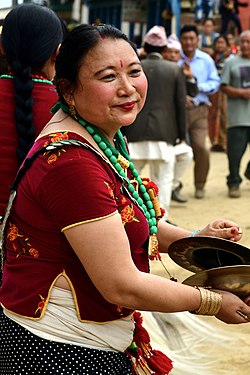

This article needs additional citations for verification. Please help improve this articlebyadding citations to reliable sources. Unsourced material may be challenged and removed.
Find sources: "Taal" instrument – news · newspapers · books · scholar · JSTOR (April 2021) (Learn how and when to remove this message) |
 |
The taalormanjira (also spelled manjīrāormanjeera), jalra, karatala, kartalorgini is a pair of clash cymbals,[1] originating in the Indian subcontinent, which make high-pitched percussion sounds. In its simplest form, it consists of a pair of small hand cymbals.[2] The word taal comes from the Sanskrit word Tālà, which literally means a clap. It is a part of Indian music and culture, used in various traditional customs e.g. Bihu music, Harinaam etc. It is a type of Ghana vadya.
In Hindu religious contexts it is known as karatala (karatāla; kara "hand", "arm" and tāla "rhythm", "beat"), typically used to accompany devotional music such as bhajan and kirtan. They are commonly used by Hare Krishna devotees when performing harinam, but are ubiquitous to all Hindu devotional music. It is also called karatalaorkartal (pronounced as “kartel”) in some contexts.

There are many types of Taal, categorised by size, weight and appearance.

The instrument is played in Nepal as well, known as the Jhyamta (Nepali: झ्याम्टा) (phonetic: Jhyāmṭā), a Nepali traditional musical instrument. The Kirat community uses this with dhol (kirat)) in various cultural festivals such as Sakela, Chyabrung, Udhauli, Ubhauli and other social functions.
In Tibetan culture, the tingsha is a very similar instrument.
Manjiras are commonly played in folk and devotional music. They are played in various religious events and ceremonies in India and especially in bhajans. Manjiras are ancient musical instruments. Manjiras can be seen in many ancient temple pictures.
Manjiras have a significant importance in Gujarati and Marathi folk music. In Maharashtra they are known as Taal. Initially Manjiras were played in aarti. In Gujarat and Maharashtra, manjiras hold great importance and are played in bhajan, santvani and dayro.
|
| |
|---|---|
| Drum kit |
|
| Classical |
|
| Traditional |
|
| Manufacturers |
|
| Topics |
|